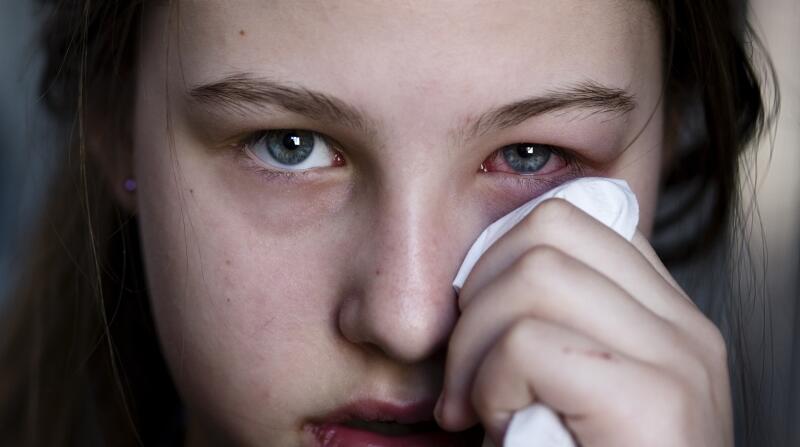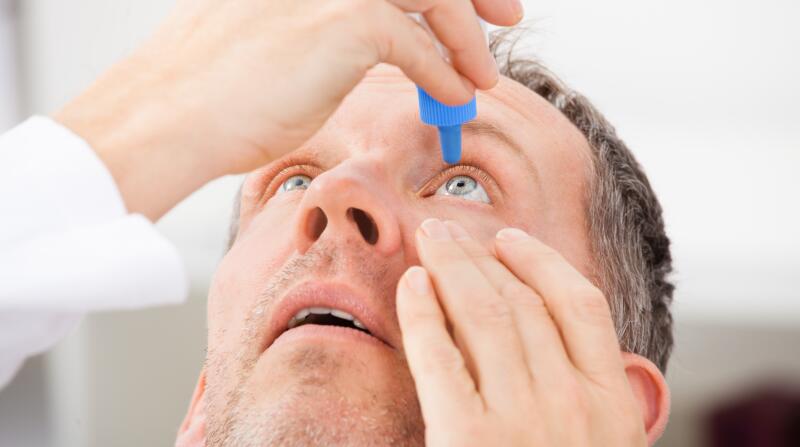Dry Eye: 10 Things Doctors Want You to Know

Medically Reviewed By William C. Lloyd III, MD, FACS
Written By Lorna Collier on September 4, 2020
-
 As screen use climbs, so do dry eye symptoms.Experts estimate dry eye syndrome, also referred to as dry eye, affects more than 16 million adults in the United States. People age 50 and up are most likely to have dry eyes, with the condition more common in women. However, a recent survey finds that younger people—living in a multi-screen world—are increasingly likely to have symptoms as well. Here’s what three eye doctors with expertise in dry eye want you to know about how to recognize and treat this common (and underdiagnosed) disorder.
As screen use climbs, so do dry eye symptoms.Experts estimate dry eye syndrome, also referred to as dry eye, affects more than 16 million adults in the United States. People age 50 and up are most likely to have dry eyes, with the condition more common in women. However, a recent survey finds that younger people—living in a multi-screen world—are increasingly likely to have symptoms as well. Here’s what three eye doctors with expertise in dry eye want you to know about how to recognize and treat this common (and underdiagnosed) disorder. -
 1. “Watering eyes may actually indicate dry eye.”Symptoms of dry eye include, of course, dryness. But another symptom that often surprises patients is wetness. "You'll get watering and that's the most confusing of all," says Stephanie Marioneaux, MD, an ophthalmologist in private practice in Chesapeake, Va. She explains that tears in dry eye syndrome are "emergency tears coming to rescue the surface of the eye," such as when a draft blows on it. Other symptoms: pain (sometimes stabbing, sometimes burning or aching), redness, tired eyes, feeling like you have sand in your eyes, and periods of blurred vision.
1. “Watering eyes may actually indicate dry eye.”Symptoms of dry eye include, of course, dryness. But another symptom that often surprises patients is wetness. "You'll get watering and that's the most confusing of all," says Stephanie Marioneaux, MD, an ophthalmologist in private practice in Chesapeake, Va. She explains that tears in dry eye syndrome are "emergency tears coming to rescue the surface of the eye," such as when a draft blows on it. Other symptoms: pain (sometimes stabbing, sometimes burning or aching), redness, tired eyes, feeling like you have sand in your eyes, and periods of blurred vision. -
-
 2. “Dry eye syndrome has many causes.”"The challenging thing is that dry eye is not a single disease," says Anat Galor, MD, associate professor of clinical ophthalmology at the Bascom Palmer Eye Institute at the University of Miami Miller School of Medicine. "It's a constellation of symptoms and signs." Dry eye can sometimes result from hormonal changes seen in menopause or, in men, andropause (loss of testosterone). Other dry eye causes include illnesses such as Sjogren's syndrome, problems in the tear system that affect tear production, medication side effects (high blood pressure pills are one type of drug that can cause dry eye), and focusing on electronic screens or books for extended periods of time.
2. “Dry eye syndrome has many causes.”"The challenging thing is that dry eye is not a single disease," says Anat Galor, MD, associate professor of clinical ophthalmology at the Bascom Palmer Eye Institute at the University of Miami Miller School of Medicine. "It's a constellation of symptoms and signs." Dry eye can sometimes result from hormonal changes seen in menopause or, in men, andropause (loss of testosterone). Other dry eye causes include illnesses such as Sjogren's syndrome, problems in the tear system that affect tear production, medication side effects (high blood pressure pills are one type of drug that can cause dry eye), and focusing on electronic screens or books for extended periods of time. -
 3. “Don’t forget to blink.”"Dry eye is an epidemic now because of what people are doing, which is staring," says Dr. Marioneaux, who regularly treats children as young as 6 for dry eye. "Everybody is staring at a computer or cell phone or cable TV or whatever." The result? People aren't blinking, which means their eyes dry out. Marioneaux says we need to blink every four seconds to avoid dryness and inflammation. She advises putting sticky notes on your computer with the word "BLINK!" Dr. Galor also suggests using lubricating eye drops before computer sessions, which may let you work a little longer before symptoms crop up.
3. “Don’t forget to blink.”"Dry eye is an epidemic now because of what people are doing, which is staring," says Dr. Marioneaux, who regularly treats children as young as 6 for dry eye. "Everybody is staring at a computer or cell phone or cable TV or whatever." The result? People aren't blinking, which means their eyes dry out. Marioneaux says we need to blink every four seconds to avoid dryness and inflammation. She advises putting sticky notes on your computer with the word "BLINK!" Dr. Galor also suggests using lubricating eye drops before computer sessions, which may let you work a little longer before symptoms crop up. -
 4. “Contact lens wearers might need to switch to glasses.”Contact lens use is a risk factor for dry eye, says Esen Akpek, MD, professor of ophthalmology at the Johns Hopkins University School of Medicine in Baltimore. Dr. Akpek recommends her patients use high water content daily contacts, which can make contacts workable for someone prone to dry eye. But sometimes, she says, "If a patient has a bad enough dry eye, they should not be wearing contacts, since the situation will become worse." That's because contacts can cause inflammation of the surface of the eye, decreasing the quantity and quality of tears.
4. “Contact lens wearers might need to switch to glasses.”Contact lens use is a risk factor for dry eye, says Esen Akpek, MD, professor of ophthalmology at the Johns Hopkins University School of Medicine in Baltimore. Dr. Akpek recommends her patients use high water content daily contacts, which can make contacts workable for someone prone to dry eye. But sometimes, she says, "If a patient has a bad enough dry eye, they should not be wearing contacts, since the situation will become worse." That's because contacts can cause inflammation of the surface of the eye, decreasing the quantity and quality of tears. -
 5. “Check your environment for dry eye triggers.”Ten years ago, dry eye was thought to be mostly age-related or due to conditions outside one's control, like a physical problem with your eye, Dr. Akpek says. "But nowadays we understand environmental factors play a huge role." One factor is exposure to allergens. "We think many patients with dry eye have underlying allergy, especially because the diagnosis of dry eye peaks during the spring when pollen peaks," says Dr. Galor, who recommends anti-allergy eye drops. Also, suggests Dr. Akpek, you may need to increase the humidity in your home or office, since dry air can lead to dry eyeballs. Adjusting fans and vents so they don’t blow air on your eyes can help, too, says Dr. Marioneaux.
5. “Check your environment for dry eye triggers.”Ten years ago, dry eye was thought to be mostly age-related or due to conditions outside one's control, like a physical problem with your eye, Dr. Akpek says. "But nowadays we understand environmental factors play a huge role." One factor is exposure to allergens. "We think many patients with dry eye have underlying allergy, especially because the diagnosis of dry eye peaks during the spring when pollen peaks," says Dr. Galor, who recommends anti-allergy eye drops. Also, suggests Dr. Akpek, you may need to increase the humidity in your home or office, since dry air can lead to dry eyeballs. Adjusting fans and vents so they don’t blow air on your eyes can help, too, says Dr. Marioneaux. -
-
 6. “What you eat can improve your dry eye symptoms.”"Certain nutritional components have been found to help with dry eye," says Dr. Galor. Omega-3 fatty acids get the biggest nod from researchers. These compounds are found in foods such as flaxseed, salmon and walnuts, as well as fish oil supplements. "I tell patients to try to get it from a healthy diet, but certainly supplements are another option," says Dr. Galor. However, you may have to ingest omega-3s for a couple of months before improvement starts to show, says Dr. Marioneaux. "It's not a quick fix, but it does help."
6. “What you eat can improve your dry eye symptoms.”"Certain nutritional components have been found to help with dry eye," says Dr. Galor. Omega-3 fatty acids get the biggest nod from researchers. These compounds are found in foods such as flaxseed, salmon and walnuts, as well as fish oil supplements. "I tell patients to try to get it from a healthy diet, but certainly supplements are another option," says Dr. Galor. However, you may have to ingest omega-3s for a couple of months before improvement starts to show, says Dr. Marioneaux. "It's not a quick fix, but it does help." -
 7. “Don’t overdo it with the eye drops.”Taking over-the-counter artificial tears more than eight times a day means they’re not working, says Dr. Akpek. "A lot of my patients are taking these eye drops like every 5 to 10 minutes," under the impression that "the more you take, the better." But eye drops actually are a "physical trauma to the tear layer," she says, and need to be used judiciously. Other no-nos include taking antihistamines for allergy in hopes of helping itchy eyes; these only dry the eyes and worsen the problem. Also avoid anti-redness drops, which mask symptoms and can cause a rebound effect, meaning you will need to use more and more eye drops to achieve the same result, plus may have problems if you try to stop using them.
7. “Don’t overdo it with the eye drops.”Taking over-the-counter artificial tears more than eight times a day means they’re not working, says Dr. Akpek. "A lot of my patients are taking these eye drops like every 5 to 10 minutes," under the impression that "the more you take, the better." But eye drops actually are a "physical trauma to the tear layer," she says, and need to be used judiciously. Other no-nos include taking antihistamines for allergy in hopes of helping itchy eyes; these only dry the eyes and worsen the problem. Also avoid anti-redness drops, which mask symptoms and can cause a rebound effect, meaning you will need to use more and more eye drops to achieve the same result, plus may have problems if you try to stop using them. -
 8. “I’m optimistic about new dry eye treatments.”One new device recently approved by the Food and Drug Administration, but not yet widely available in doctors' offices, uses small prongs inserted into the nose to stimulate nerves into making tears. Dr. Akpek says she is optimistic this can help, noting that manufactured eye drops aren't as good as natural tears, so having a device to help people make their own tears is an exciting step. However, more studies are needed to show how and whom it helps. Dr. Galor also provides some patients eye drops made from their own blood at her center's eye bank. Researchers are studying the approach to see why it works. Dr. Galor says one theory is that nerve growth factor in the blood serum helps patient's tears regenerate.
8. “I’m optimistic about new dry eye treatments.”One new device recently approved by the Food and Drug Administration, but not yet widely available in doctors' offices, uses small prongs inserted into the nose to stimulate nerves into making tears. Dr. Akpek says she is optimistic this can help, noting that manufactured eye drops aren't as good as natural tears, so having a device to help people make their own tears is an exciting step. However, more studies are needed to show how and whom it helps. Dr. Galor also provides some patients eye drops made from their own blood at her center's eye bank. Researchers are studying the approach to see why it works. Dr. Galor says one theory is that nerve growth factor in the blood serum helps patient's tears regenerate. -
 9. “Dry eye tends to be a chronic disease.”Most patients with dry eye aren't going to be cured, but can learn to successfully manage the condition, says Dr. Galor. "People need to be realistic. At this point, we can't make their eyes feel like they did when they were 20." It can take a little while to figure out with your ophthalmologist which dry eye treatments work best. However, "Eventually we are able to get almost everyone on a regimen that works for them," she says. Treatments may include over-the-counter or prescription eye drops, in-office procedures, and surgery.
9. “Dry eye tends to be a chronic disease.”Most patients with dry eye aren't going to be cured, but can learn to successfully manage the condition, says Dr. Galor. "People need to be realistic. At this point, we can't make their eyes feel like they did when they were 20." It can take a little while to figure out with your ophthalmologist which dry eye treatments work best. However, "Eventually we are able to get almost everyone on a regimen that works for them," she says. Treatments may include over-the-counter or prescription eye drops, in-office procedures, and surgery. -
 10. “Dry eye can cause serious problems, so see your eye doctor.”Chronic dry eye that isn't controlled can result in complications, such as corneal damage, that could cause loss of vision, says Dr. Akpek. Or, what you may think is dry eye could be another problem entirely, says Dr. Marioneaux. "In this day and age, people refer frequently to Dr. Google for their medical information, but the bottom line is Dr. Google doesn't replace the expertise of the ophthalmologist," says Dr. Marioneaux. "The eye is very complex and you only have one pair, so if you are having issues you need to be evaluated by an MD."
10. “Dry eye can cause serious problems, so see your eye doctor.”Chronic dry eye that isn't controlled can result in complications, such as corneal damage, that could cause loss of vision, says Dr. Akpek. Or, what you may think is dry eye could be another problem entirely, says Dr. Marioneaux. "In this day and age, people refer frequently to Dr. Google for their medical information, but the bottom line is Dr. Google doesn't replace the expertise of the ophthalmologist," says Dr. Marioneaux. "The eye is very complex and you only have one pair, so if you are having issues you need to be evaluated by an MD."
Your Opinion Matters!
In order to improve our content, we want to hear from you. Please take this short anonymous survey to let us know how we’re doing.
Take the survey!
Dry Eye: 10 Things Eye Doctors Want You to Know





















